The ancient Greek playwrights in their tragedies resorted to the plot device deus ex machina (god from the machine) to solve a seemingly unsolvable problem by an unexpected occurrence.
In similar fashion, in 1957 the plot device gynaika ex machina (woman from the machine) solved a seemingly unsolvable problem for Fort Worth police.
George Rennie “Jack” Nesbit was an underworld overachiever. Below are a few ways the local press described him in the 1950s:
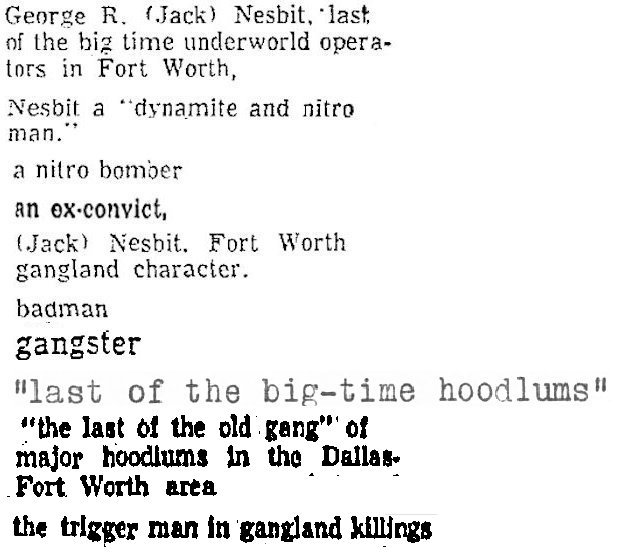 Nesbit’s arrest record dated back to at least 1927, and he had served at least two prison terms: for forgery and grand larceny.
Nesbit’s arrest record dated back to at least 1927, and he had served at least two prison terms: for forgery and grand larceny.
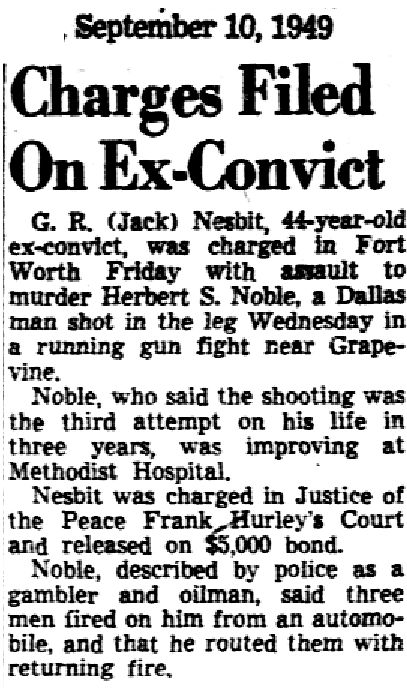 In 1949 Nesbit was charged with assault to murder after shooting fellow gambler Herbert Noble during a rolling gunfight. Noble would endure several such attempts on his life.
In 1949 Nesbit was charged with assault to murder after shooting fellow gambler Herbert Noble during a rolling gunfight. Noble would endure several such attempts on his life.
Nesbit may have used a gun on Noble, but Nesbit’s preferred tools were a stick of dynamite, a bottle of nitroglycerin, and a box of matches.
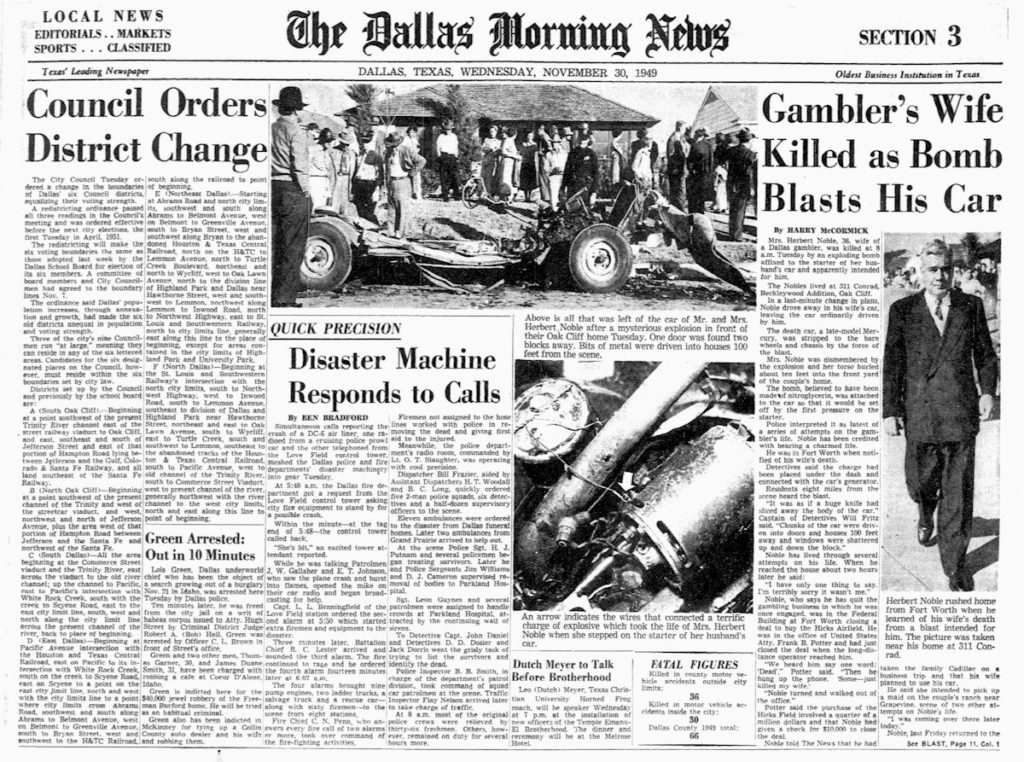 Later in 1949 Nesbit was suspected in the car-bombing that no doubt was intended to kill Herbert Noble but instead killed his wife Mildred at their home in Oak Cliff. Noble had earlier left their home in his wife’s car, leaving her to take his. A charge of nitroglycerin had been connected to his car’s generator.
Later in 1949 Nesbit was suspected in the car-bombing that no doubt was intended to kill Herbert Noble but instead killed his wife Mildred at their home in Oak Cliff. Noble had earlier left their home in his wife’s car, leaving her to take his. A charge of nitroglycerin had been connected to his car’s generator.
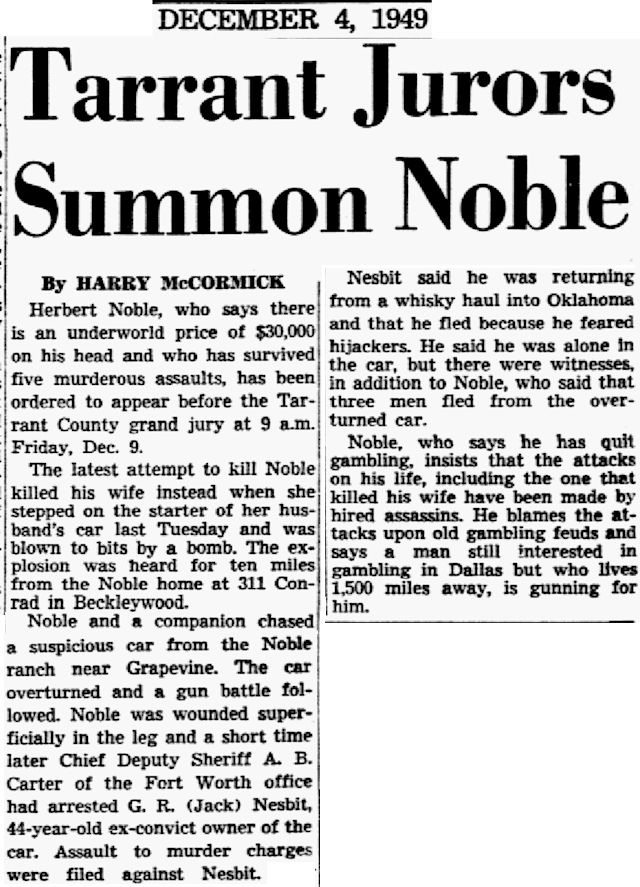 A Tarrant County grand jury subpoenaed Herbert Noble, who insisted he was no longer a gambler and blamed the attempts on his life on old gambling feuds. He said there was a $30,000 price on his head. Meanwhile, Nesbit explained the rolling gunfight with Noble by claiming he had been returning from a whiskey haul in Oklahoma and feared hijackers.
A Tarrant County grand jury subpoenaed Herbert Noble, who insisted he was no longer a gambler and blamed the attempts on his life on old gambling feuds. He said there was a $30,000 price on his head. Meanwhile, Nesbit explained the rolling gunfight with Noble by claiming he had been returning from a whiskey haul in Oklahoma and feared hijackers.
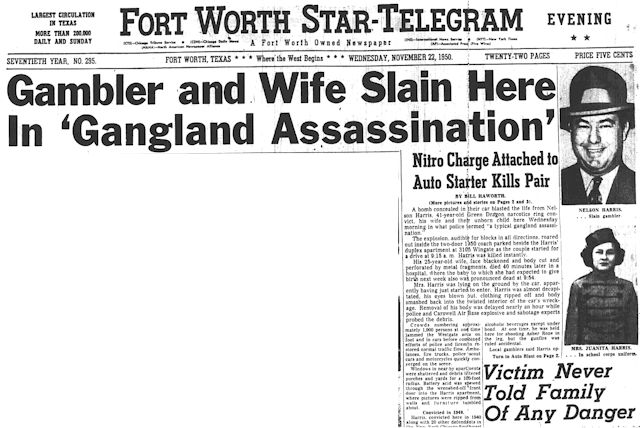 Another year, another car-bombing: This time gambler Nelson Harris and his pregnant wife were blown up on November 22, 1950 on Fort Worth’s near West Side by a charge of nitroglycerin.
Another year, another car-bombing: This time gambler Nelson Harris and his pregnant wife were blown up on November 22, 1950 on Fort Worth’s near West Side by a charge of nitroglycerin.
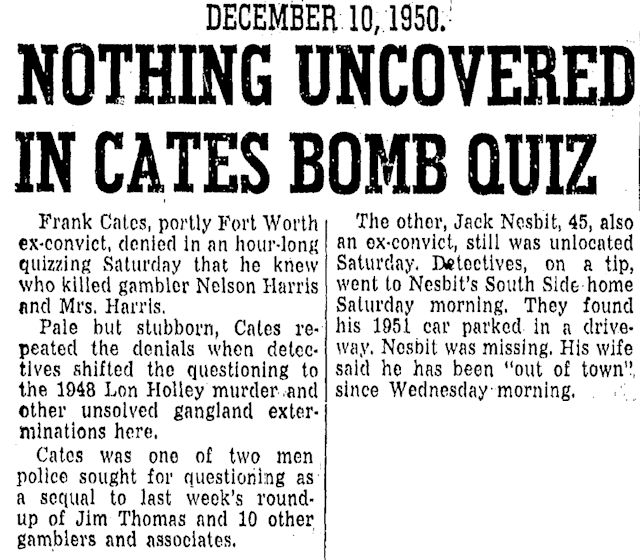
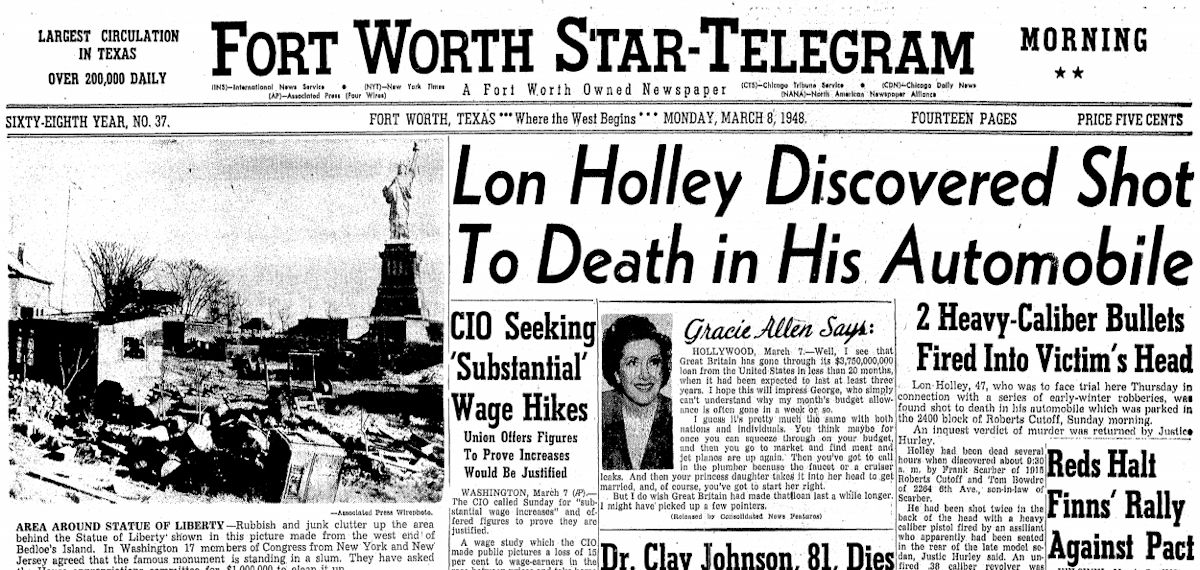 Police questioned gambler Frank Cates about the Harris car-bombing and the 1948 murder of Lon Holley. Holley was killed just as he was about to go on trial for a string of robberies. Police speculated that Holley had been silenced before he could implicate others. Jack Nesbit at times worked as Frank Cates’s bodyguard.
Police questioned gambler Frank Cates about the Harris car-bombing and the 1948 murder of Lon Holley. Holley was killed just as he was about to go on trial for a string of robberies. Police speculated that Holley had been silenced before he could implicate others. Jack Nesbit at times worked as Frank Cates’s bodyguard.
Police also had questioned hoodlum Jim Thomas in the Harris car-bombing. Jack Nesbit also was said to be Thomas’s bodyguard.
Police also wanted to talk to Nesbit about the Harris car-bombing but could not locate him.
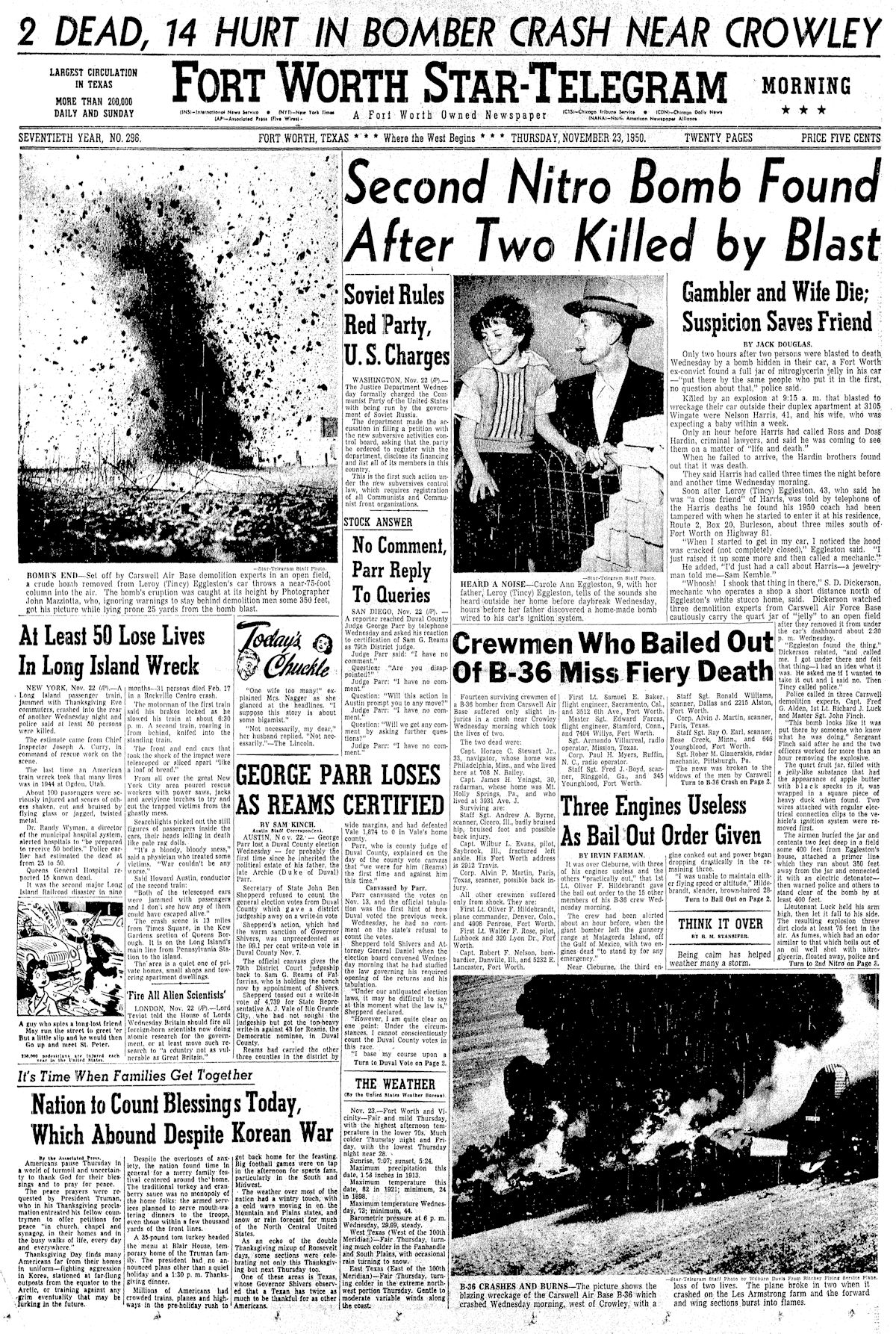 Just two hours after the Harris car-bombing, gangland figure Tincy Eggleston got in on the act: He found a fruit jar of nitroglycerin under the hood of his car! Some investigators suspected that Eggleston had committed the Harris car-bombing and had planted the nitro in his own car to divert suspicion. Other investigators pointed a finger at Jack Nesbit.
Just two hours after the Harris car-bombing, gangland figure Tincy Eggleston got in on the act: He found a fruit jar of nitroglycerin under the hood of his car! Some investigators suspected that Eggleston had committed the Harris car-bombing and had planted the nitro in his own car to divert suspicion. Other investigators pointed a finger at Jack Nesbit.
The photo at the top left of the Star-Telegram front page shows the result when demolition experts from Carswell Air Force Base buried the jar of nitro in the ground and detonated it.
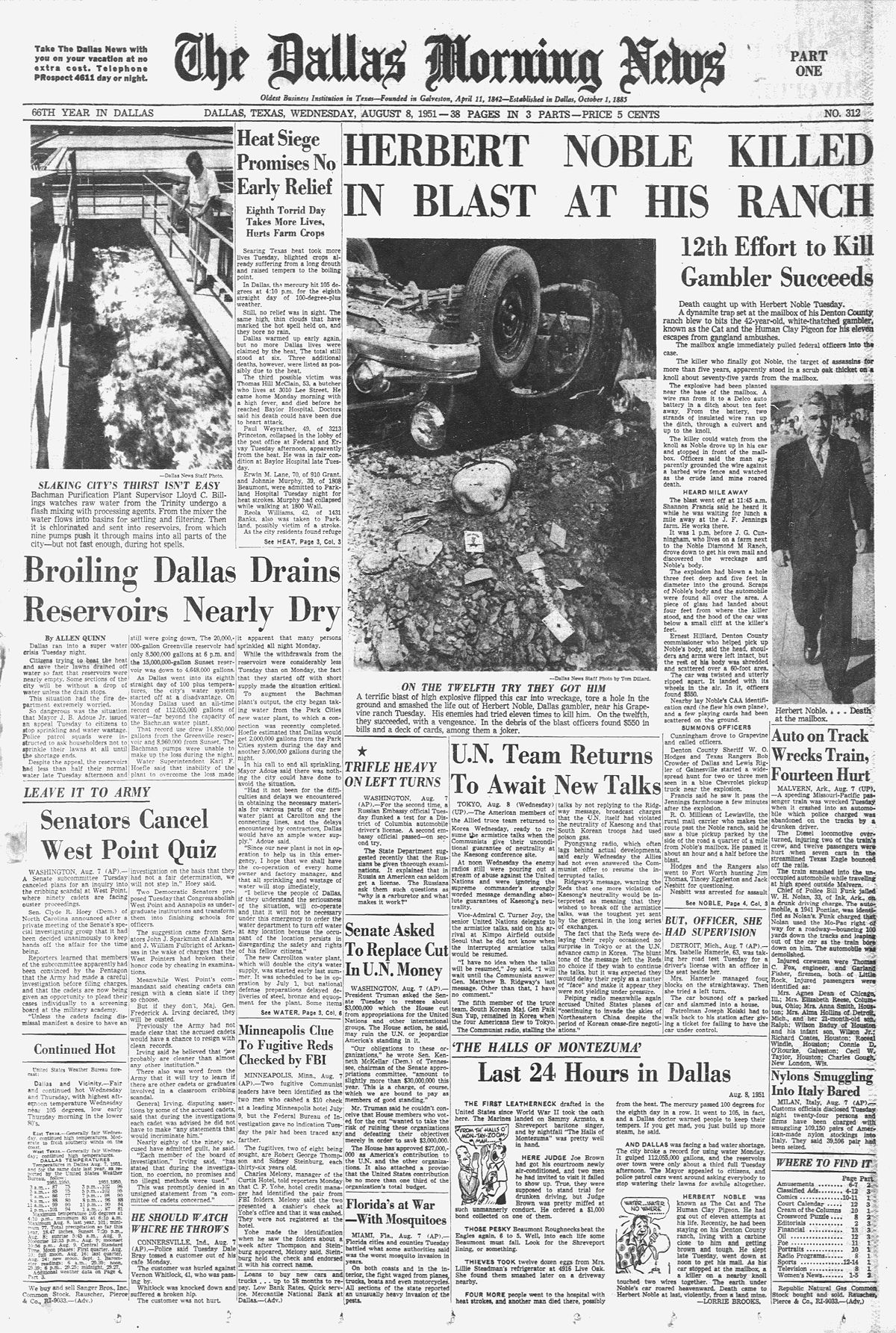 Another year, another—you guessed it—bombing. Herbert Noble had become known as “the Cat” because he had survived eleven attempts on his life. The twelfth attempt was the charm. Dynamite had been planted at the base of the mailbox of his Diamond M Ranch in Denton County. Concealed wires ran from the dynamite through a culvert to a battery and from the battery to a scrub thicket where the killer waited. When Noble stopped his car to get his mail, the killer grounded a wire against a barbed-wire fence.
Another year, another—you guessed it—bombing. Herbert Noble had become known as “the Cat” because he had survived eleven attempts on his life. The twelfth attempt was the charm. Dynamite had been planted at the base of the mailbox of his Diamond M Ranch in Denton County. Concealed wires ran from the dynamite through a culvert to a battery and from the battery to a scrub thicket where the killer waited. When Noble stopped his car to get his mail, the killer grounded a wire against a barbed-wire fence.
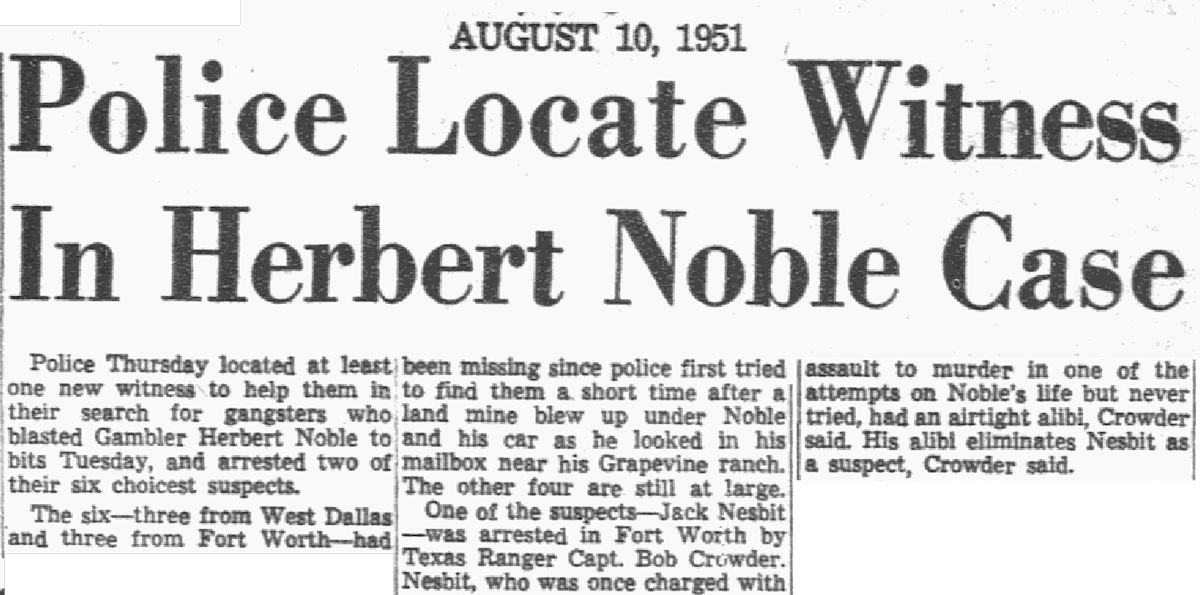 Jack Nesbit was a suspect in the Noble bombing but was found to have an airtight alibi.
Jack Nesbit was a suspect in the Noble bombing but was found to have an airtight alibi.
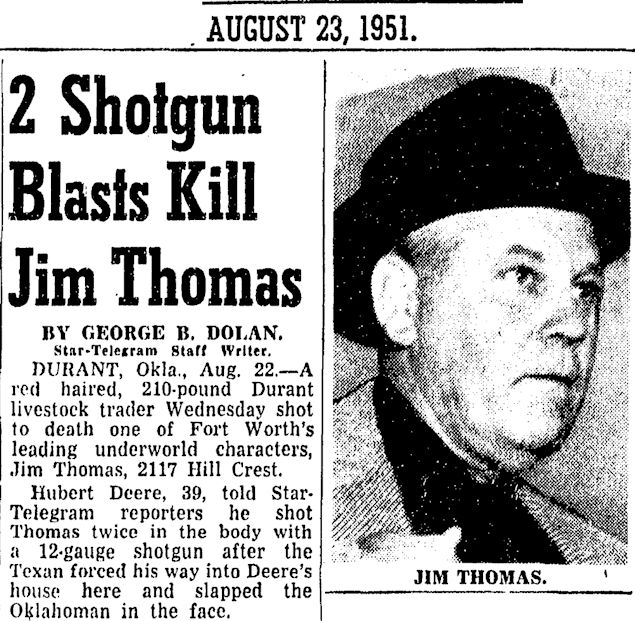 Later in August 1951 Jim Thomas was shotgunned to death in Oklahoma. Police suspected that Thomas and Nesbit had killed Herbert Noble. Note the George Dolan byline.
Later in August 1951 Jim Thomas was shotgunned to death in Oklahoma. Police suspected that Thomas and Nesbit had killed Herbert Noble. Note the George Dolan byline.
 In 1956 a “mysterious explosion” leveled Paul’s Club on East Belknap Street. Gasoline was thought to be involved, and Jack Nesbit’s name naturally came up. The owner of the club was Bill Jenkins, who had operated the Starlite Club on Jacksboro Highway, which burned in 1949.
In 1956 a “mysterious explosion” leveled Paul’s Club on East Belknap Street. Gasoline was thought to be involved, and Jack Nesbit’s name naturally came up. The owner of the club was Bill Jenkins, who had operated the Starlite Club on Jacksboro Highway, which burned in 1949.
A few days after the Paul’s Club explosion Nesbit was arrested in Paducah, Texas. He and an accomplice had soaked a building with gasoline and placed a lightbulb on a box of matches. By the time the heat of the bulb ignited the matches, Nesbit and his accomplice planned to be far away establishing an alibi by being seen in a public place by lots of witnesses.
But the two men were arrested as they left the building. They were charged with intent to commit arson.
The newspaper added that Nesbit also had been questioned in the deaths of the Harrises and the Nobles.
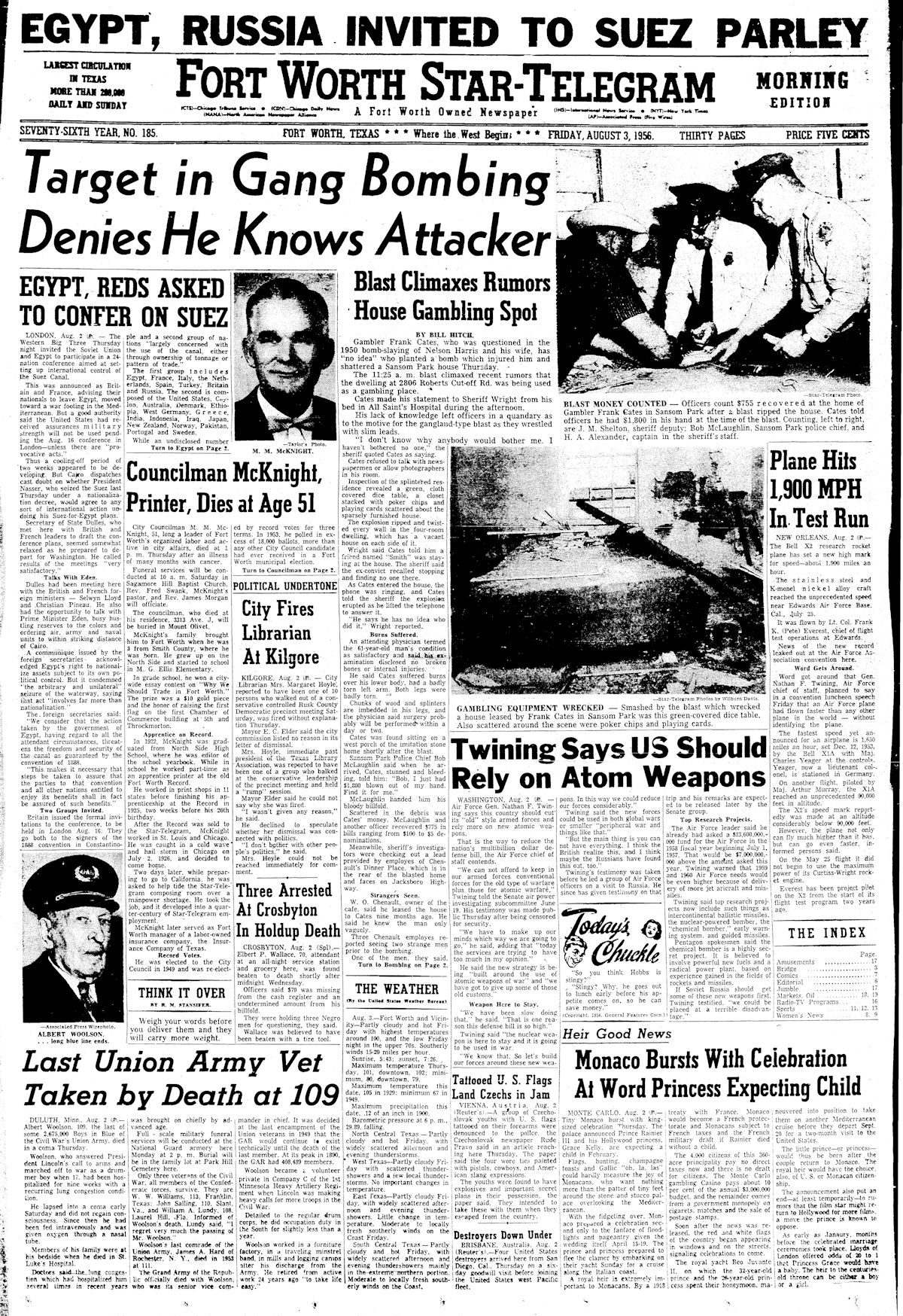 Then it was Frank Cates’s turn. On August 2, 1956 a bomb blew up a suspected gambling house just off Jacksboro Highway in Sansom Park as Cates was in the house counting money. Cates was only injured. Under the house police found wires that ran to Jacksboro Highway. Police suspected a two-man job: One man telephoned Cates from a booth on the highway, and another man in a car nearby detonated the bomb when signaled by the first man. Sounds a bit like Jack Nesbit’s MO. If Nesbit was working as Cates’s bodyguard at the time, where was he?
Then it was Frank Cates’s turn. On August 2, 1956 a bomb blew up a suspected gambling house just off Jacksboro Highway in Sansom Park as Cates was in the house counting money. Cates was only injured. Under the house police found wires that ran to Jacksboro Highway. Police suspected a two-man job: One man telephoned Cates from a booth on the highway, and another man in a car nearby detonated the bomb when signaled by the first man. Sounds a bit like Jack Nesbit’s MO. If Nesbit was working as Cates’s bodyguard at the time, where was he?
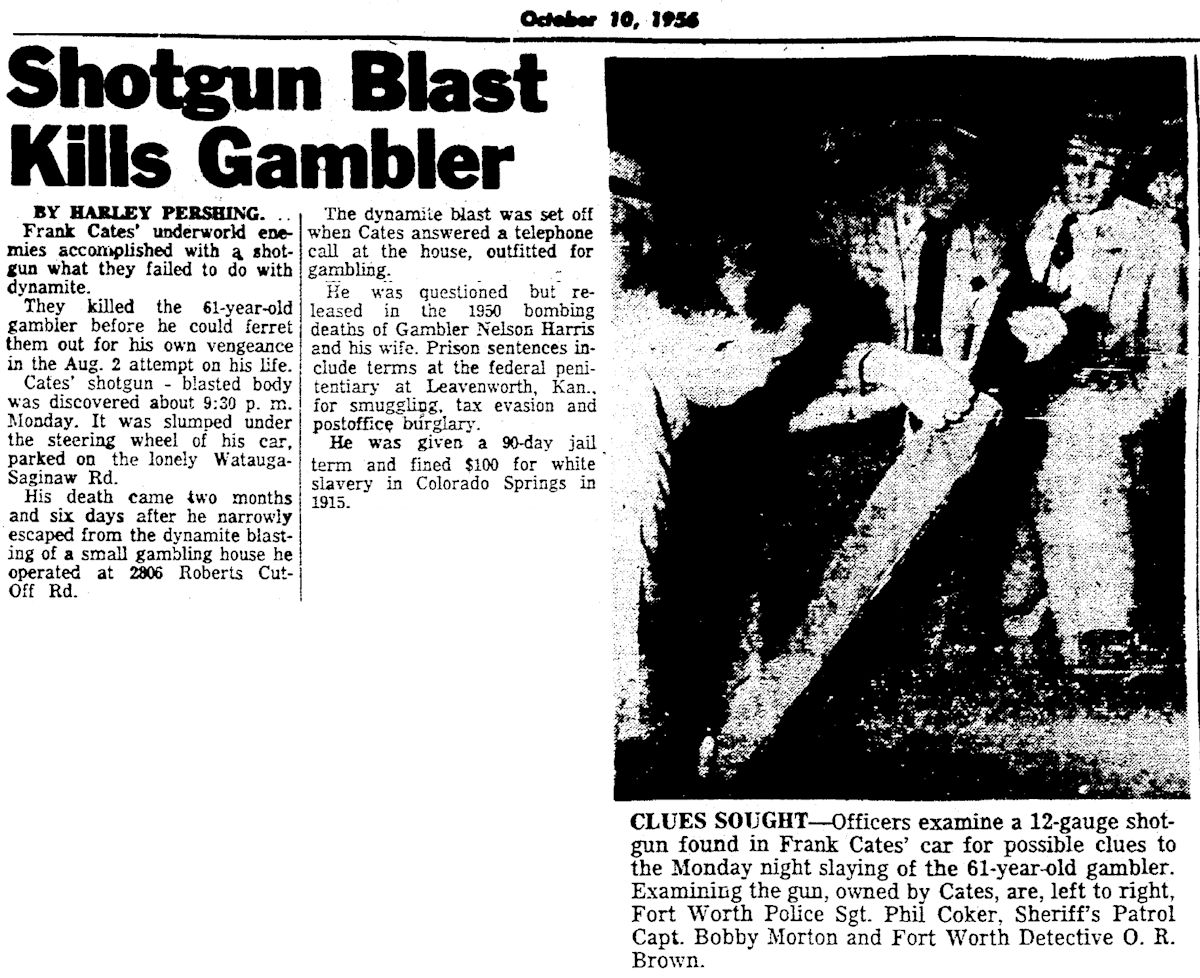 If at first you don’t succeed . . .: In October Frank Cates, like Herbert Noble, ran out of lives. He was shotgunned to death in his car on Watauga-Saginaw Road within a mile of the well that had yielded the body of Tincy Eggleston in 1955. Again, if Jack Nesbit was Cates’s bodyguard at the time, where was he?
If at first you don’t succeed . . .: In October Frank Cates, like Herbert Noble, ran out of lives. He was shotgunned to death in his car on Watauga-Saginaw Road within a mile of the well that had yielded the body of Tincy Eggleston in 1955. Again, if Jack Nesbit was Cates’s bodyguard at the time, where was he?
Then came the year 1957. Jack Nesbit was sailing along:
- He had a new girlfriend. The Dallas Morning News described Lois Stripling, thirty-one, as “a tall, good looking, reddish blonde.” She was the widow of gambler Howard Stripling, who had operated the Skyliner Club on Jacksboro Highway. Stripling had been among several gamblers questioned in the Harris car-bombing in 1950. But among gamblers, the nature of Stripling’s death had been as rare as a royal flush: He died of natural causes.
- The only charge hanging over Nesbit in 1957 was the Paducah arson case. He was free on bond.
Time and again Jack Nesbit had been suspected but not charged, charged but not convicted.
He seemed to have as many lives as Herbert Noble.
Yes, Jack Nesbit was careful in his professional life. But like many people, he was less careful in his personal life. In 1957 he made three mistakes:
- He gave girlfriend Lois Stripling a .32-caliber pistol.
- He taught her how to use it.
- He knocked her to the floor just once too often.
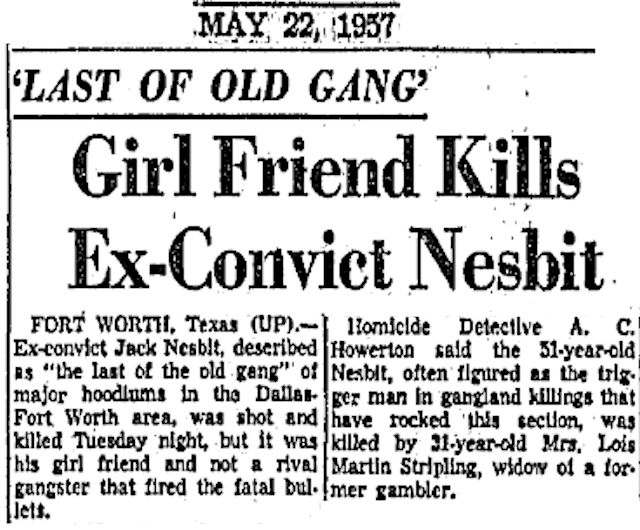 On May 21 Jack Nesbit called on Lois Stripling at her duplex at 812 Scenic Hill Drive in Riverside. The couple argued.
On May 21 Jack Nesbit called on Lois Stripling at her duplex at 812 Scenic Hill Drive in Riverside. The couple argued.
The Star-Telegram later reported that Mrs. Stripling said Nesbit “beat” her, “pushed her around,” and threatened her with a .45-caliber pistol.
“I was afraid he was going to kill me,” Mrs. Stripling told the Star-Telegram. “I wanted to leave him, and he had told me that I’d stay away only long enough for him to throw a stick of dynamite at my folks’ house. Then I’d be back—quick.”
Nesbit then went home to his wife. Mrs. Nesbit was aware of her husband’s bifurcated affection. She later said her husband was being “dogged” by Mrs. Stripling, who was trying to break up the Nesbits’ happy home.
“She called him constantly,” Mrs. Nesbit said. “We had dinner at the Colonial Cafeteria on Riverside. I told him, ‘Come be at your home,’ and he said, ‘Honey, I’ve never been away from home.’ He said, ‘I’ve only loved two women in my life. You and my mother. I want you to know I’m going over there tonight and get this doggin’ stopped.’”
That night Jack Nesbit again went to 812 Scenic Hill Drive.
And again Nesbit and Lois Stripling argued. The argument turned violent. Nesbit knocked Lois Stripling to the floor.
The Morning News later wrote: “Mrs. Stripling said ‘he came across a coffee table after me.’” She thought he had a gun, and she drew the pistol he had given her and fired point blank at him.
Four times.
Mrs. Lois Stripling, gynaika ex machina, had solved the police’s seemingly unsolvable problem of Jack Nesbit.
Police found a pistol in Nesbit’s car.
“I’m sorry I had to do it,” Mrs. Stripling said. “But he was coming after me. When he stepped over the coffee table, I let him have it. I had made up my mind I would. And he did.”
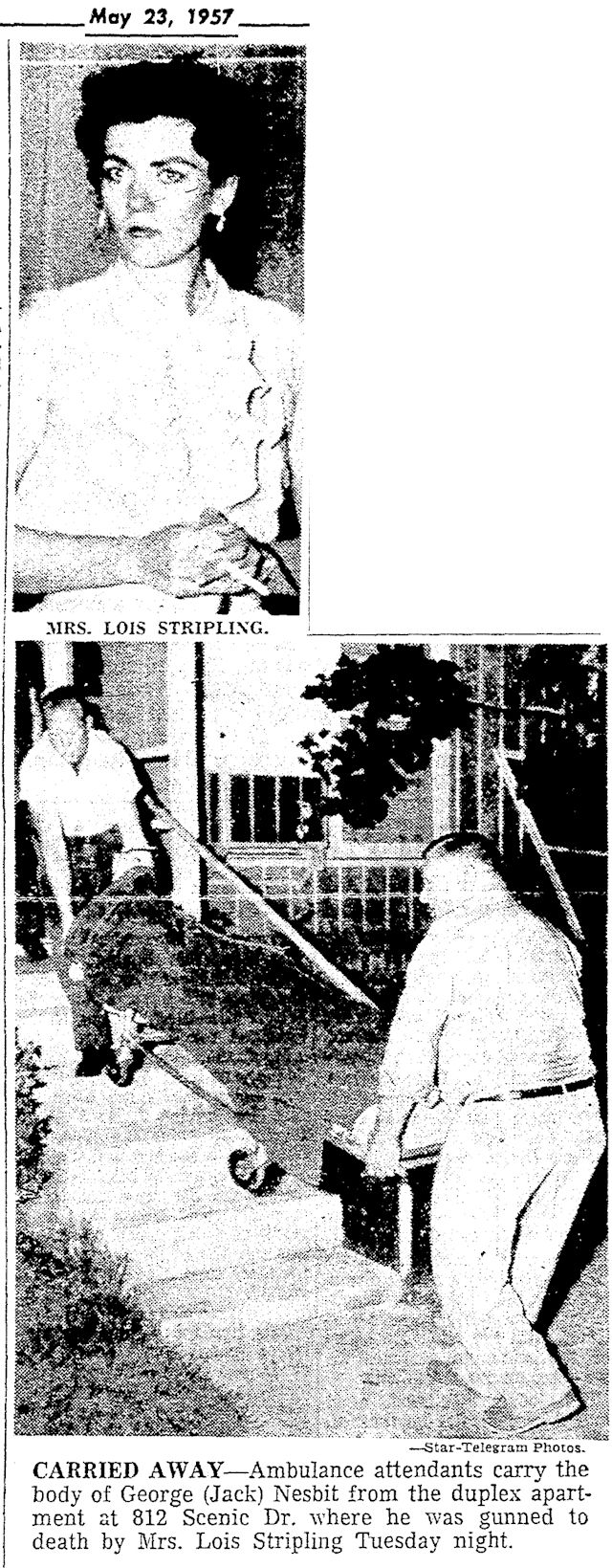
 Lois Stripling was charged with murder and freed on bond.
Lois Stripling was charged with murder and freed on bond.
Nesbit’s widow said her late husband, fifty-one, at the time of his death was a bouncer at Boston Smith’s gambling establishment on the Tarrant-Parker county line.
She said her husband was “a good provider” and “never killed anyone,” although she admitted that he had intended to burn down the Paducah building in exchange for payment by the owner.
“We had no income at the time. I was in an arthritic condition. We needed the money.”
After Mrs. Stripling killed Jack Nesbit, Fort Worth police detective A. C. Howerton, who had investigated many of Fort Worth’s gangland crimes of the 1950s, did everything but send Mrs. Stripling a thank-you note and a box of bonbons.
He said the killing was justifiable homicide and asked the grand jury to no-bill Mrs. Stripling, saying, “When you find a man so cowardly that he’ll sit on a hilltop and touch two wires together to kill Herbert Noble—and one so deadly that he’ll put a bomb in Nelson Harris’ car and kill the Harrises and their unborn child in an area where children were playing—and a man who’ll soak a business house in Paducah, Texas, with 55 gallons of gasoline because somebody paid him to burn it down—well, then, I don’t see how we can ask the law to send this woman away for ridding the Southwest of such a man.”
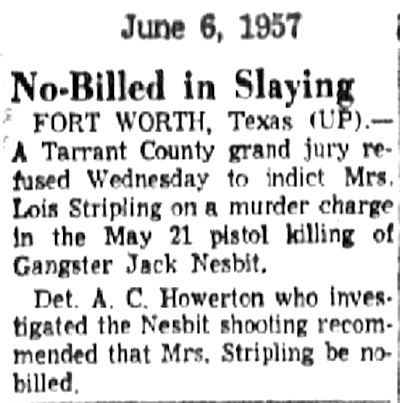 The grand jury agreed.
The grand jury agreed.
 WBAP-TV said Nesbit was the seventeenth big-time local hoodlum to meet a violent death in the postwar era.
WBAP-TV said Nesbit was the seventeenth big-time local hoodlum to meet a violent death in the postwar era.
 After the car-bombing of Chock Parrish in 1965 the Fort Worth Press would list the gangland killings in Fort Worth since 1950. Nesbit’s slaying would not be included, perhaps because Lois Stripling had acted in self-defense and was not herself a “gangland character.”
After the car-bombing of Chock Parrish in 1965 the Fort Worth Press would list the gangland killings in Fort Worth since 1950. Nesbit’s slaying would not be included, perhaps because Lois Stripling had acted in self-defense and was not herself a “gangland character.”
 After the dust and drama had settled, Mrs. Stripling told the Star-Telegram that she had received offers of help from strangers, encouragement from religious groups, even proposals of marriage from men.
After the dust and drama had settled, Mrs. Stripling told the Star-Telegram that she had received offers of help from strangers, encouragement from religious groups, even proposals of marriage from men.
But she announced that she was leaving Texas to start a “new life.” She said she would find work as a bookkeeper or stenographer or dental assistant. She might go even to South America.
“I’ve been running in the wrong crowd,” she said, perhaps with no hint of understatement.
“I’m still pretty scared,” she said, “because he [Nesbit] still has some friends around here who are bad enough to hurt me.”
Added the femme fatale: “I’m through with men. Now, seriously, don’t you think I should be?”





